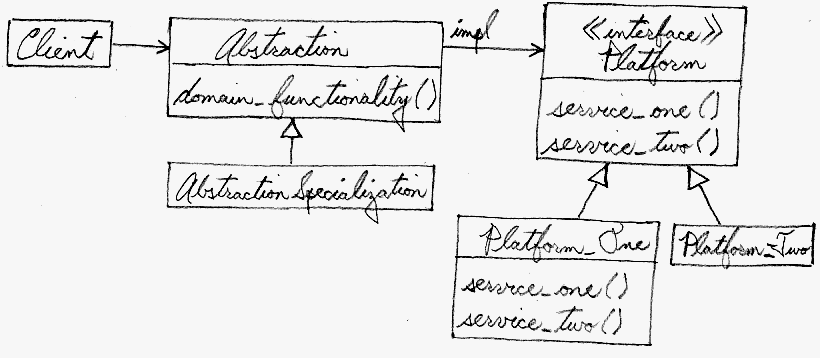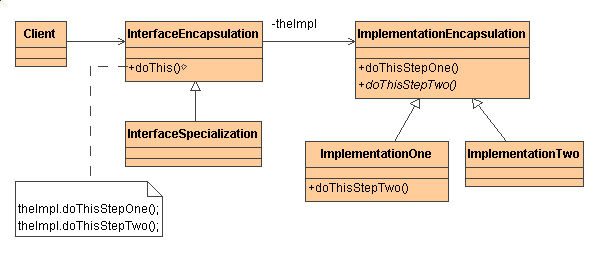Bridge
Intent
- Decouple an abstraction from its implementation so that the two
can vary independently. [GoF, p151]
- Publish interface in an inheritance hierarchy, and bury
implementation in its own inheritance hierarchy.
- Beyond encapsulation, to insulation
Problem
"Hardening of the software arteries" has occurred by using subclassing
of an abstract base class to provide alternative implementations. This
locks in compile-time binding between interface and implementation.
The abstraction and implementation cannot be independently extended or
composed.
Structure Summary
 Structure category: wrapper + inheritance hierarchy
Structure category: wrapper + inheritance hierarchy
Similar patterns:
Builder
Observer
State
Motivation
Consider the domain of "thread scheduling".

There are two types of thread schedulers, and two types of operating
systems or "platforms". Given this approach to specialization, we
have to define a class for each permutation of these two dimensions.
If we add a new platform (say ... Java's Virtual Machine), what would
our hierarchy look like?

What if we had three kinds of thread schedulers, and four kinds of
platforms? What if we had five kinds of thread schedulers, and ten
kinds of platforms? The number of classes we would have to define
is the product of the number of scheduling schemes and the number
of platforms.
The Bridge design pattern proposes refactoring this exponentially
explosive inheritance hierarchy into two orthogonal hierarchies –
one for platform-independent abstractions, and the other for
platform-dependent implementations.

Discussion
Decompose the component's interface and implementation into orthogonal
class hierarchies. The interface class contains a pointer to
the abstract implementation class. This pointer is initialized with an
instance of a concrete implementation class, but all subsequent interaction
from the interface class to the implementation class is limited to the
abstraction maintained in the implementation base class. The client
interacts with the interface class, and it in turn "delegates" all
requests to the implementation class.
The interface object is the "handle" known and used by the client;
while the implementation object, or "body", is safely encapsulated to
ensure that it may continue to evolve, or be entirely replaced (or shared
at run-time.
Use the Bridge pattern when:
- you want run-time binding of the implementation,
- you have a proliferation of classes resulting from a coupled
interface and numerous implementations,
- you want to share an implementation among multiple objects,
- you need to map orthogonal class hierarchies.
Consequences include:
- decoupling the object's interface,
- improved extensibility (you can extend (i.e. subclass) the
abstraction and implementation hierarchies independently),
- hiding details from clients.
Bridge is a synonym for the "handle/body" idiom [Coplien, C++
Report, May 95, p58]. This is a design mechanism that
encapsulates an implementation class inside of an interface class. The
former is the body, and the latter is the handle. The handle is viewed
by the user as the actual class, but the work is done in the body.
"The handle/body class idiom may be used to decompose a complex
abstraction into smaller, more manageable classes. The idiom may
reflect the sharing of a single resource by multiple classes that
control access to it (e.g. reference counting)." [Coplien,
Advanced C++, p62]
Structure
The Client doesn't want to deal with platform-dependent details.
The Bridge pattern encapsulates this complexity behind an abstraction
"wrapper".

Bridge emphasizes identifying and decoupling "interface" abstraction
from "implementation" abstraction.

Example
The Bridge pattern decouples an abstraction from its implementation, so
that the two can vary independently. A household switch controlling
lights, ceiling fans, etc. is an example of the Bridge. The purpose of
the switch is to turn a device on or off. The actual switch can be
implemented as a pull chain, simple two position switch, or a variety
of dimmer switches. [Michael Duell, "Non-software examples of software
design patterns", Object Magazine, Jul 97, p54]

Check list
- Decide if two orthogonal dimensions exist in the domain. These
independent concepts could be: abstraction/platform, or
domain/infrastructure, or front-end/back-end, or interface/implementation.
- Design the separation of concerns: what does the client want,
and what do the platforms provide.
- Design a platform-oriented interface that is minimal, necessary,
and sufficient. Its goal is to decouple the abstraction from the platform.
- Define a derived class of that interface for each platform.
- Create the abstraction base class that "has a" platform object
and delegates the platform-oriented functionality to it.
- Define specializations of the abstraction class if desired.
Rules of thumb
Adapter makes things work after they're designed; Bridge makes them
work before they are. [GoF, p219]
Bridge is designed up-front to let the abstraction and the
implementation vary independently. Adapter is retrofitted to make
unrelated classes work together. [GoF, p216]
State, Strategy, Bridge (and to some degree Adapter) have similar solution
structures. They all share elements of the "handle/body" idiom
[Coplien, Advanced C++, p58]. They differ in intent -
that is, they solve different problems.
The structure of State and Bridge are identical (except that Bridge
admits hierarchies of envelope classes, whereas State allows only
one). The two patterns use the same structure to solve different
problems: State allows an object's behavior to change along with its
state, while Bridge's intent is to decouple an abstraction from its
implementation so that the two can vary independently. [Coplien,
C++ Report, May 95, p58]
If interface classes delegate the creation of their implementation
classes (instead of creating/coupling themselves directly), then the
design usually uses the Abstract Factory pattern to create the
implementation objects. [Grand, Patterns in Java, p196]







